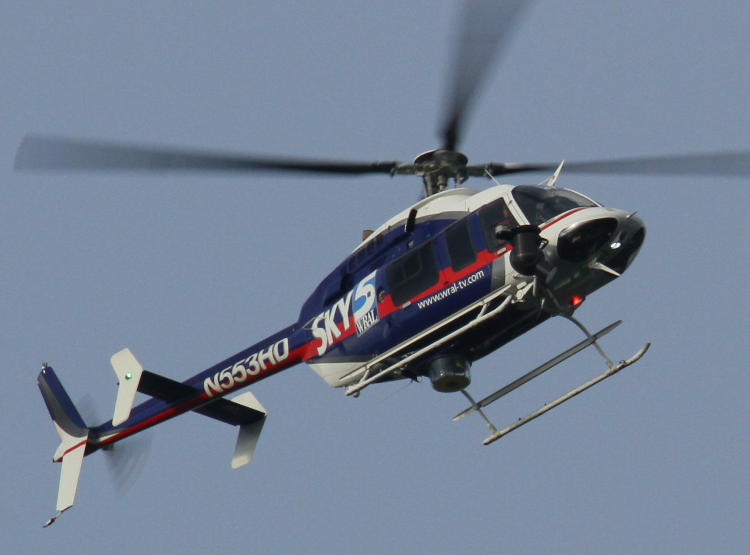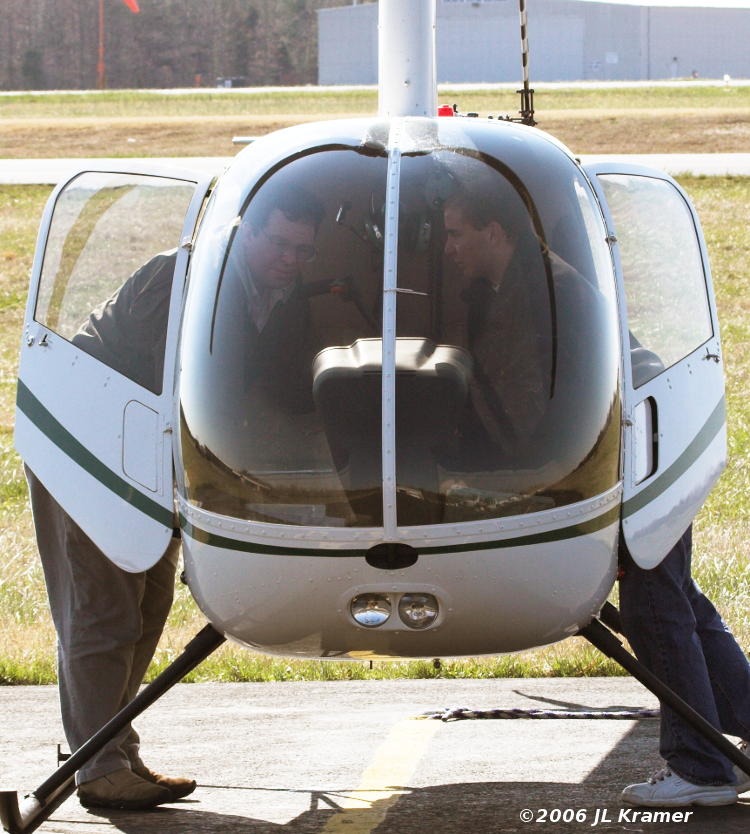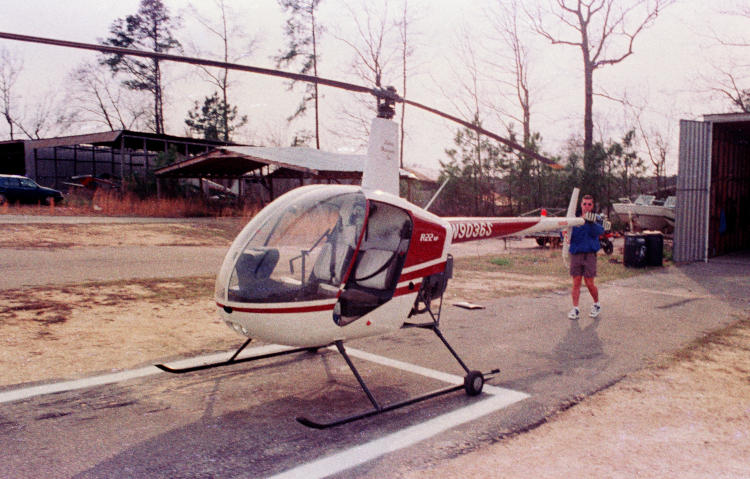I’ve kicked this story around for a few years, debating about posting it because it’s not at all thematic, regardless of the various themes, and I’m never really sure if anyone would care. But then again I do detailed closeups of creepy things, so what the hell. Plus, it’s Provide Unwanted and Disregarded Insight Into Yourself Day, so what better time to post this? And it serves as a reminder for everyone else to post their own.
We’ll open with (what used to be) the oldest image in the blog folder, and in fact, half of these weren’t taken by me – because they’re largely of me. This was in that uncivilized time when selfies were unknown, but even if they had existed then, it would have been challenging, to say the least, to accomplish. This one is The Girlfriend’s photo, back in 2006.

Yes, that’s me in the cockpit, at the controls even. Though, given how level the helicopter is, chances are very good that I’m not in control, but have had it taken from me for a moment by the instructor to re-stabilize the aircraft – he’s blocked by the doorframe. Ever since I was eight years old or so, I’ve had an interest in learning to fly helicopters, and on just two occasions (so far, anyway,) I’ve had the chance to indulge this interest.
It all began with a little police show called, “Chopper One” back in the early ’70s, which featured the relatively new Bell 206B ‘Jetranger’ as the aircraft, sleek and maneuverable. If you like, take a look at the helicopter models produced up until that point and recognize that the only thing that looked slicker was the Bell AH-1 ‘Cobra’ attack helicopter, which I hadn’t yet seen. Everything else was pretty dumpy-looking and slow.

Then came the New York State Fair in Syracuse, somewhere around 1976 or ’77, when they were offering brief rides in the very same model over the fairgrounds, and my brother and I took the opportunity (for a very reasonable amount of money, too.) I was permitted the front seat and thus got the best view as we lifted off, a strange bobbing feeling of moving in three dimensions freely, and then circling over overcast, dirty, industrial Syracuse (the fairgrounds are in a really shitty location,) but hey, I was hooked. That was my first flight of any kind, actually, though within two years I’d fly down to Florida with my family on commercial airlines.
And then, for years, no chance at all to fly anywhere in anything, much less helicopters. But in 1992 when I was living in North Carolina, I took a trip up to New York again to visit family, and did a side trip out to Niagara Falls. We spotted the sightseeing helicopter pad and stopped to inquire about the cost, finding it within my budget, and so I took my second ride, this time in a McDonnell-Douglas MD-500E, even sleeker (and a bit quieter) than the Jetranger. My sister’s family opted to take a ride too, stretching their budget to the limit, but for the next two circuits the sightseeing company, not having a full bird, elected to allow my two nieces to ride for free while I chafed on the ground and cursed their narrow asses.

Tragically, several months later one of their aircraft collided with another sightseeing helicopter operating from the Canadian side and crashed into the ravine east of the falls, killing all onboard. Years afterward I was reviewing the National Transportation Safety Board report regarding the accident and was appalled at the lack of coordination and communication between the two companies. They basically operated on open, unplanned flights in the very small airspace over the falls without any communication, schedules, or airspace restrictions, relying only on visually spotting one another. It’s amazing something hadn’t happened earlier.
That wasn’t enough to deter me, however, and sometime in the mid-nineties I had a little disposable income and elected to take my first introductory lesson, a half-hour of ground school (mostly preflight) and a half-hour of actual, at-the-controls flight time. This was to take place in a Robinson R-22 HP, roughly the same model in the opening photo though that’s from a different flight – we’re getting to that.
That first lesson was on a beautiful day, and as we did the preflight orientations and walkaround, the instructor pilot removed the door from his side, a trivial thing to do, to give us better visibility and access to the various controls and certificates. Once we’d finished with that and were about to fire up the helicopter for the flight, he started to pick the door back up, then shrugged and left it there, saying it was too nice a day to close it up. Then he looked at me and asked if I wanted my door removed too.
I’m a guy; I immediately said, Sure – why not? and he promptly popped the door on my side free from its hinges. At this point in the story, let’s have a closer look at the R-22.

The cabin itself is literally just over a meter wide, seating two abreast – yes, you’re practically rubbing shoulders, with the doors (should they be affixed) sitting right at your hip. Since they run almost the entire height of the cabin, this means that, not affixed, it’s wide open on that side. As we lifted off (under the instructor’s control) and headed out, I was paying too much attention to the instruments and lesson to really be much aware of this – up until I had the controls and was doing banking practice. A 30° bank is typical but a little steep if you’re not used to it, and while the left bank (towards the instructor’s side) was just fine, he had to keep telling me to bank harder for the right bank, my side, since I was hanging over completely open space with a junkyard full of twisted metal about 300 meters below; subconsciously, I kept easing away from this. I need to emphasize that banking doesn’t actually mean you’re hanging from your seat harness, because the motion of the aircraft is counteracting gravity and you’re more pressed into your seat, but visually, I was over a bad drop and I was reacting to it.

This deserves its own recognition. A helicopter of course relies on that spinning main rotor, and while on the ground gravity and friction cause everything to behave as we expect. But once in the air, the helicopter body wants to spin the opposite direction that the rotor does because there’s a bit of wind resistance to spinning that rotor, and so the tail rotor counteracts this. Feeding more or less power (blade pitch, really) into it makes the body spin in one direction or another, so the yaw pedals also help control which way you’re facing. And helicopters are inherently unstable: without constant input from all three of these, a helo will quickly decay into a worsening situation, i.e., a crash. Coordinating all three of these at the same time is the key bit of course.
So, at our return to the airport, we found a grassy spot away from traffic and, at less than two meters off the ground, began getting acquainted with each of these. Well, I began – the instructor seemed to have it down pat. We started with the yaw pedals, and he had me stabilize and hold the aircraft facing exactly in one direction while he maintained the other two controls. Not too difficult, and the subsequent four-point compass turn went quite smoothly. Next he took over the yaw and had me control the collective to maintain our altitude. Not quite as slick this time; you’d think maintaining altitude would only require finding the sweet spot where lift and descent were balanced, but these alter constantly with wind and movement, so we did a bit of up-and-down as I got the hang of compensating for these little environmental changes, but eventually it wasn’t too shabby.
Then he had me do both of these at once, and all hell broke loose. As I devoted my attention to one, the other would decay and we’d start spinning, or dipping, or both. This is far from being as easy as it sounds, believe me; adjustments to the collective to maintain a steady altitude also affect how much wind resistance the main rotor encounters, and thus how much the body wants to spin, so any adjustment to the collective needs a commensurate adjustment to the yaw pedals. It does not help that the minimal mass of the R-22 means it is incredibly twitchy, subject to the faintest breezes and angle changes, and very easy to feed too much power into.
Then the instructor took over those controls and had me do the cyclic.

All I had to do was hold the bird steady in one position, without worrying about yaw or altitude. Now, you remember first learning how to drive, and the overcontrolling thing where you turned a little too hard, then too much back when compensating, and started weaving? Magnify that times a hundred. What the instructor failed to tell me was that there’s a lag between the control input and its actual affect on the helicopter, so if you hold the stick over until you feel the pitch change, you’re probably already too far gone; what it takes is a little bump on the stick to counter the slide to one side, then returning the stick to neutral upright position before anything appeared to happen. What actually happened was that we, repeatedly, started with a little wobble that soon magnified into wild oscillations – in every direction. I’m not the kind of guy that ever gets sweaty palms, but goddamn did it happen on that flight. Essentially, every ten to fifteen seconds the instructor would announce that he was taking control and restabilize our attitude, then hand it over to me to ruin again; he had to keep telling me to stop drying my right hand at these times and keep it on the stick.
I’m going to insert a little detail here, because it’s cute. Balance is a big thing for aircraft of course, and this shows on the ground too. After that lesson we hangared the Robinson, and this is remarkably easy. He had me go to the tail of the helicopter and push up on it, which lifted the rear ends of the skids off of the ground, and he slotted two specially-made little tires in place. Then he took over and pulled down on the tail, rocking the aircraft back until it was supported entirely on these wheels, and walked it into the hangar like a handtruck. It’s that light and easy to move.

I was by myself on that flight (well, except for the instructor,) and while I got these couple of photos, they were all post-flight on ancient negatives. But then in 2006, The Girlfriend gifted me another introductory flight (with Jim Kramer along for kicks, thus the source of the other, better photos,) where I largely repeated this process, albeit with slightly more control this time. Slightly. Let’s put it this way: FAA requirements for a rotary-wing certification requires minimum 20 hours with an instructor, and at least 10 of those are typically spent learning to hover in various conditions. You’re pushing against air, which is remarkably fickle and capricious – picture how kites bob without any change in attitude or configuration. When something is suspended in the air, this same capriciousness has a noticeable affect, regardless of the method of holding it within the air; while the blades are pushing down to lift the helicopter, the breeze may be shifting it sideways, and it may perhaps be pushing off of a surface that causes more turbulence and throws out its own lateral effects. Then, the helicopter tends to tilt a little with every input because, again, there’s nothing holding it steady, and that tilt goes straight into the main rotor shaft and causes more lateral effect. It’s hard, and requires a long time to get used to and know what it takes to correct. Fixed wing flight, while no walk in the park, is loads easier to learn.

I was nowhere near the point of learning autorotation, which I consider the most harrowing aspect of rotary-wing flight instruction. Most people believe that if the engine fails in a helicopter, you’re screwed, but this isn’t really the case; the technique of autorotation (which is a required part of obtaining a license) provides for a controlled descent. In essence, changing the pitch of the main rotor blades allows them to keep spinning at a viable speed just from the wind of the descending helicopter, and their own lift properties means they can regulate this rate of descent; it’s a lot like those little seeds that helicopter down from trees. Rotor speed must be maintained in a narrow window, with the pitch being changed to appropriate within a few seconds of the failure or disengagement of the engine (itself controlled via a clutch,) and the rate of descent really can’t be altered, so during this, you’re looking for a clear landing area. Landings may be anything from just a little awkward to rough but survivable, but it’s a crucial technique and, yes indeed, performed during instruction. I remember being at Cape Canaveral in Florida and seeing a Schweizer 300 (pretty much the same size as the R-22s seen here) approaching in the distance, then suddenly begin a rapid descent. I lost sight of it behind the trees and watched that area for a while with nothing to see, then shrugged it off. About ten minutes later I saw the exact same thing again, same spot, and knew the local flight school was practicing autorotation.
But anyway, since those two instructional opportunities of mine, nothing more. Flight instruction is expensive, and I just don’t have that kind of disposable income. Moreover, there’s not a lot of reason to drop the cash. Even a lightweight like the R-22 here costs about $200 an hour to operate, without a lot of reasons why I would/should spend that, just for cruising around. It’s not even an investment on future employment, because there really isn’t much demand for helo pilots, in this area or indeed most. In a six-county region, we have a handful of law enforcement helicopters, a pair for the news stations, and another handful of medevacs for the hospitals – that totals maybe thirty positions for all shifts, and all requiring turbine ratings. That’s actually additional instruction over top of a basic rotary-wing license; the R-22 operates on a piston engine, but just about everything else (including the first-mentioned Jetranger) runs on jet turbines, an entirely different set of operational rules. Moreover, all of those potential employers prefer to have experience, lots of hours in a logbook, so that would also be coming out of my own pocket – nearly everyone just hires ex-military pilots, already certified and with hundreds of operational hours.
Which means that this… is probably all it’s gonna be. Even if I get a lot more income not directed towards something else, I still couldn’t really justify spending that much on what is essentially frivolous indulgence, as much as I might like flying in helicopters; it’d just be very expensive sightseeing, with the occasional very expensive trip out to the coast or something (and you don’t want to know how little luggage is going into an R-22.) I’m glad that I had the opportunity, twice, and will remain an enthusiast, looking up every time a helicopter passes over; no one will need to ask twice if there’s ever a spare seat in one at any time. But the chances of my being at the controls are in the single-digit percentage now.
Maybe I need to get a motorcycle again…




















































